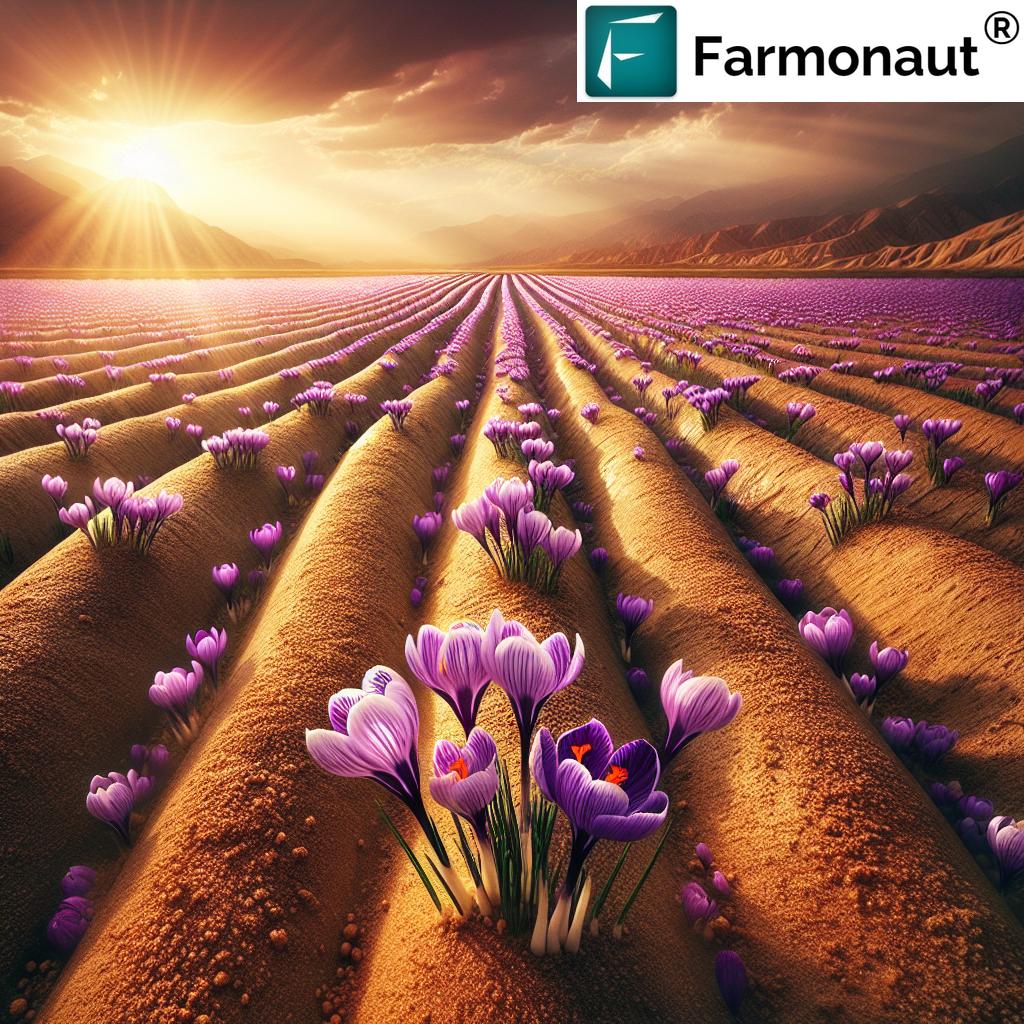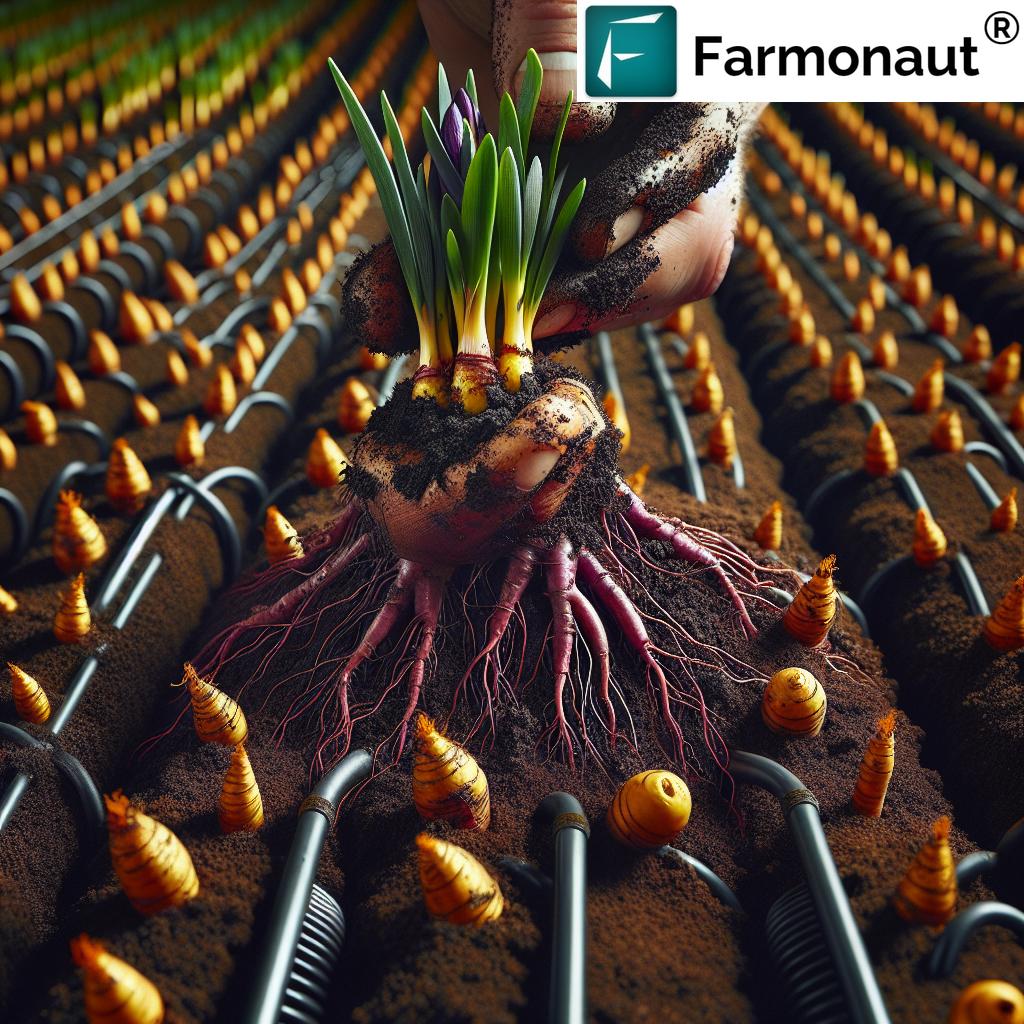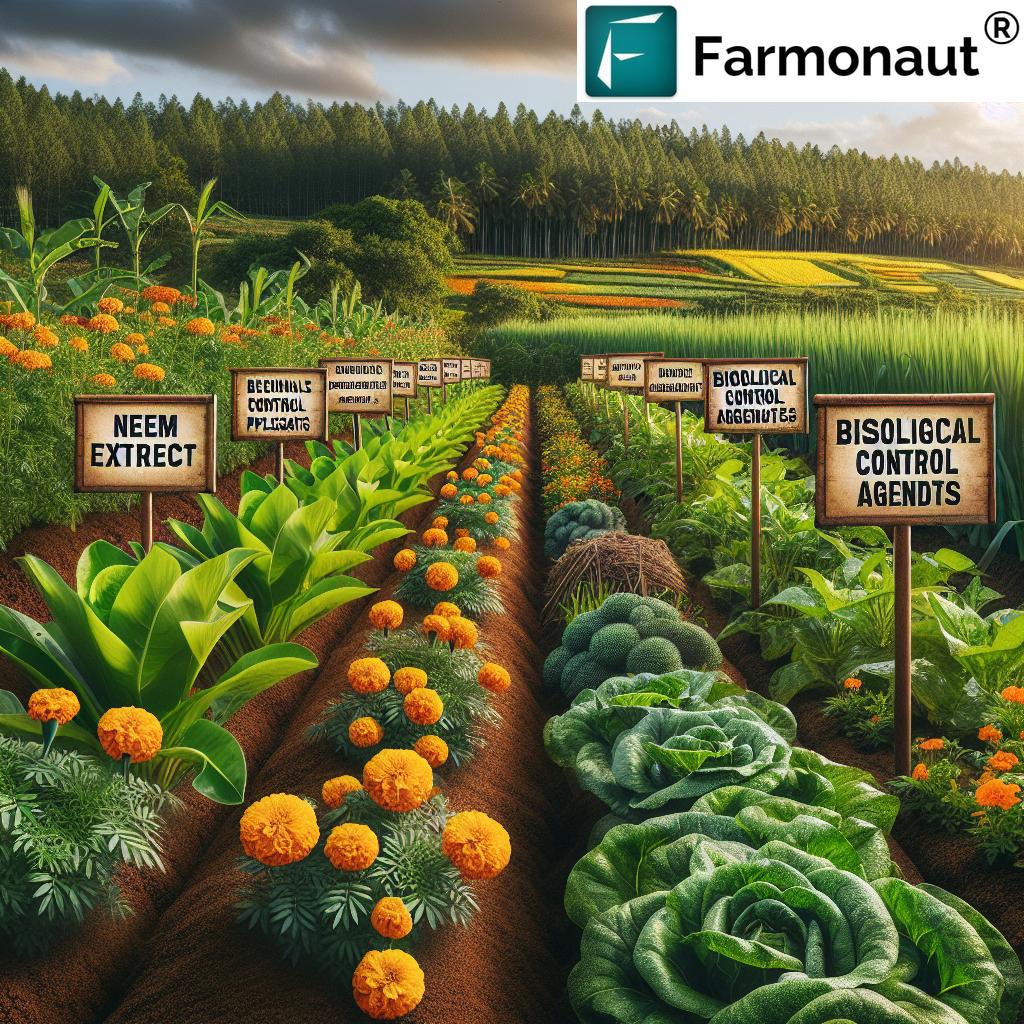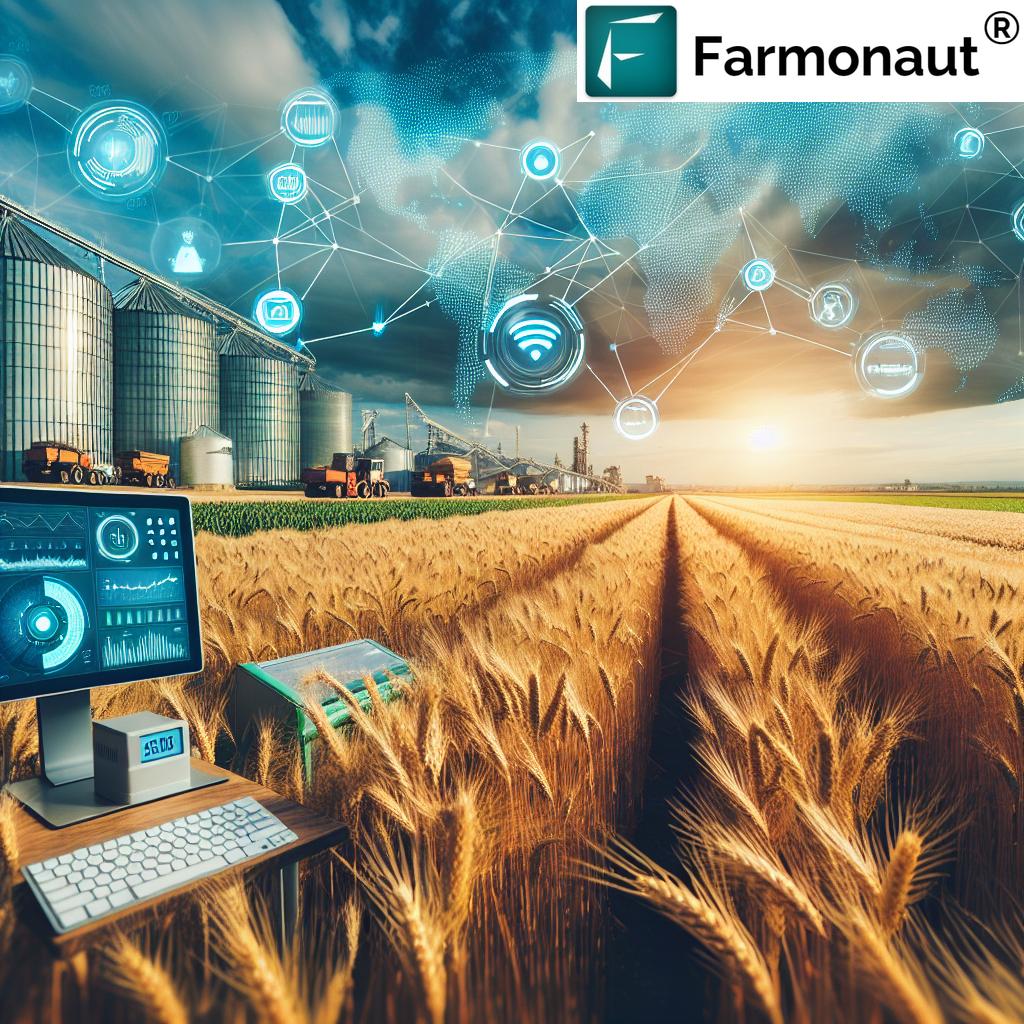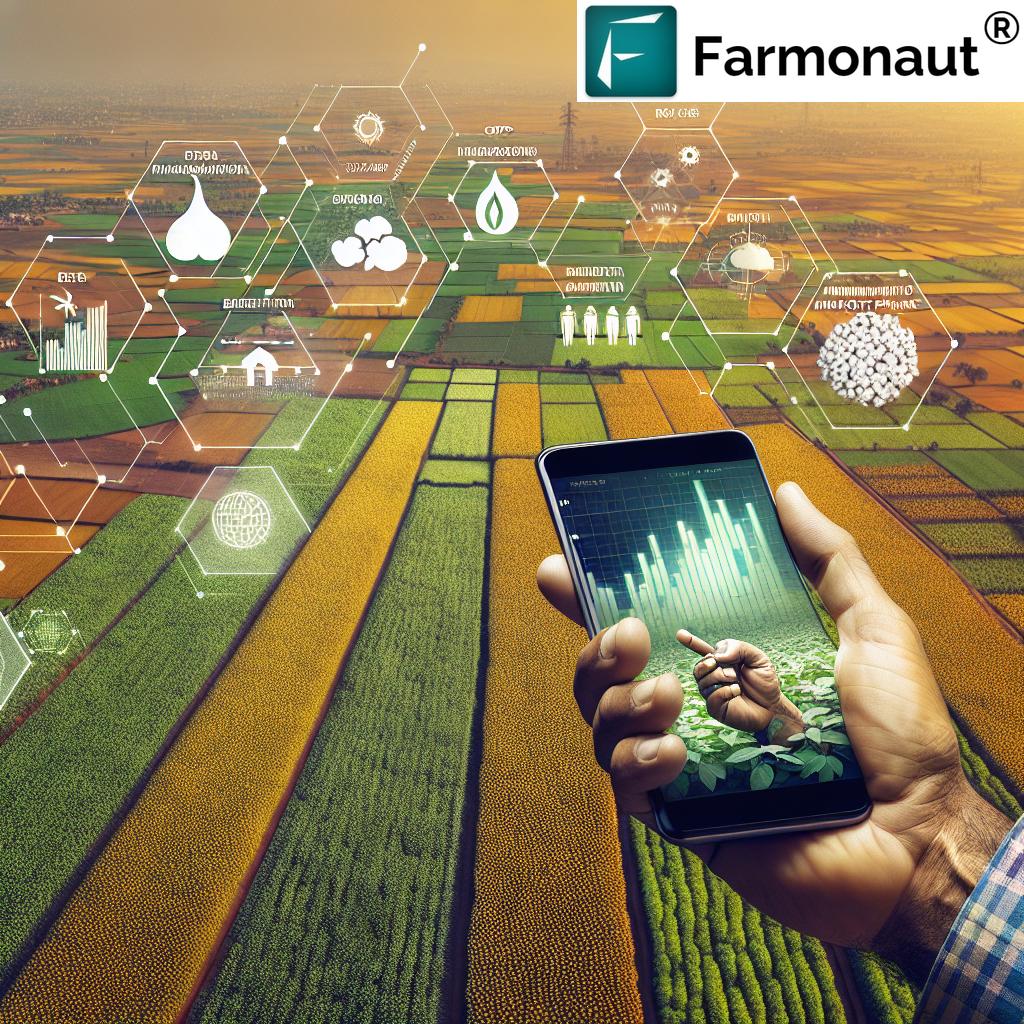Iranian Saffron Farming Techniques: 7 Sustainable Ways
Saffron cultivation in Iran is a tale of tradition, resilience, and innovation. As we delve into the heart of this country’s agricultural pride, we uncover how Iranian farmers have mastered the delicate balance between age-old methods and modern sustainable practices. Through centuries, saffron has shaped the landscapes of regions such as Khorasan Razavi province, coloring our markets, our diets, and even our identity. Today, against a backdrop of changing climates, water scarcity, and global demand, the world’s leading saffron producers are at the frontier of an agricultural revolution.
In this comprehensive guide, we’ll explore the seven most effective and sustainable techniques for saffron farming in Iran—including traditional methods, organic approaches, and the latest advancements. We’ll also address the challenges of saffron cultivation, highlight key innovations, and introduce- how digital tools like Farmonaut are shaping future possibilities in precision agriculture and resource management.
Traditional Saffron Cultivation Methods in Iran
The essence of saffron farming in Iran is deeply enshrined in its traditional methods, honed over centuries across arid and semi-arid climates, especially in the iconic Khorasan Razavi province. Understanding these time-tested methods is pivotal in appreciating the profound sustainability embedded in Iranian agriculture.
Climate, Timing, and Site Selection
- Climates: Saffron thrives in arid and semi-arid climates. The regions of Khorasan Razavi, South Khorasan, and North Khorasan are globally recognized for optimum saffron production.
- Timing: Preparation begins in late summer (August), with corms or bulbs entering dormancy. Sowing is executed in early September to maximize growth in cooler months.
- Soil: Sandy, well-drained soils with pH ranging between 7 and 8 provide optimal conditions. The soil is carefully cleared of weeds and fortified with organic matter, typically animal manure.
Land Preparation and Planting
- The land is ploughed and leveled, ensuring it is free from stones and clods which may interfere with corm placement.
- Saffron corms (unlike seeds!) are selected for disease resistance and size, favoring those weighing at least 8-10 grams.
- Traditional practice involves planting corms 15–20 cm apart and 10–15 cm deep, maximizing exposure to moderate moisture and aeration.
- Organic and chemical fertilizers—notably phosphorus and potassium—support robust growth in subsequent seasons.
Irrigation: The Whirlpool Method
- The first round of watering is performed in late September using the whirlpool irrigation method, ensuring even distribution across the field.
- Strategic irrigations are timed to key growth stages, with management aiming to avoid waterlogging—a major cause of corm damage.
- Shallow land ploughing helps with the emergence of leaves and stems, ensuring a vigorous saffron plant.
These traditional methods of saffron cultivation in Iran form the backbone of the country’s dominance in global production, setting quality standards for this prized spice.
7 Sustainable Saffron Farming Techniques in Iran
While the country’s success draws heavily from its ancient wisdom, sustainable saffron production demands adaptation. Now, we examine the top 7 sustainable techniques increasingly adopted by Iranian farmers to protect both yields and natural resources for the future:
-
1. Organic Saffron Farming
- Organic methods avoid synthetic chemical fertilizers—instead, farmers use animal manure, compost, and green matter. This boosts beneficial soil organisms and improves water retention.
- Natural pest management strategies—such as trap crops and manual weed removal—minimize environmental impact, safeguarding the flavor and color of the spice.
- Benefit: Healthier soil and increased biodiversity; in some cases, yield can increase by up to 30% compared to conventional means.
-
2. Drip Irrigation & Precision Water Management
- Advanced saffron irrigation techniques such as drip systems deliver water directly to the corm root zone, minimizing waste and preventing soil salinization—a key threat in arid provinces.
- The adoption of digital monitoring—increasingly enabled through Farmonaut precision tools—empowers farmers to make well-informed decisions, optimize irrigation schedules, and minimize water stress impacts.
- Outcome: Greater water efficiency (reducing usage by up to 60%) and safeguarding both yields and corm health.
-
3. Crop Rotation and Polyculture Systems
- Rotating saffron with legumes, cumin, or wheat disrupts pest lifecycles and refreshes soil nutrients. This reduces dependency on chemicals and prevents soil exhaustion.
- Polyculture—planting saffron alongside compatible crops—encourages beneficial interactions, elevating both biodiversity and yield sustainability.
-
4. Controlled Greenhouse Saffron Cultivation
- Greenhouse methods allow year-round control over temperature, humidity, and light, protecting saffron plants from climate variability and unpredictable frosts.
- While slightly costlier at the outset, greenhouse production delivers higher and more stable yield per hectare, optimizes resource management, and cuts water use.
-
5. Microbial & Biofertilizer Enrichment
- Microbial inoculants and biofertilizers enhance root strength, bolster nutrient uptake, and stimulate organic matter decomposition, gradually revitalizing soils depleted by centuries of harvest.
- This method aligns with the demand for organic saffron in high-value markets, as chemical residue is minimized.
-
6. Satellite-Based Crop Monitoring & Data-Driven Advisory
- Integrating satellite imagery and AI advisories (as offered through Farmonaut’s real-time crop health platform) allows farmers to:
- Monitor vegetation health (NDVI, soil moisture, water stress)
- Detect early signs of disease or pest infestations
- Receive custom guidance on fertilizer and irrigation management
- Eco-Impact: This yields smarter resource use, cost cuts, and improved yields, contributing to sustainable saffron production.
- Learn how to track your farm’s carbon footprint here and contribute to more sustainable agriculture.
-
7. Blockchain-Based Product Traceability
- Authenticity and transparency are paramount in global saffron markets. Blockchain solutions (such as Farmonaut Product Traceability) create a secure record of every step—from production to shipping—reducing fraud and increasing consumer trust.
- Result: Fair compensation for farmers, greater access to export markets, and preservation of Iran’s reputation for high-quality saffron.
By adopting these seven sustainable methods, Iranian saffron farmers are transforming agriculture to meet modern economic, environmental, and global challenges.
The Saffron Harvesting Process & Post-Harvest Quality
Time-Sensitive Harvest
- Harvesting of saffron flowers unfolds just once per year, typically in early November. Well-coordinated teamwork is crucial, as flowers must be picked pre-dawn (before sunrise) to protect essential flavor and color.
- Each saffron flower contains three crimson stigmas; separating these by hand is a highly skilled task, pivotal to quality control.
- Yield Perspective: It takes around 2,000–2,300 flowers to produce a mere 12 grams of marketable saffron!
Processing Excellence
- Fresh stigmas are gently dried either by air or controlled heat—an art form in itself. The drying stage directly influences aroma, color intensity, and the preservation of bioactive compounds.
- Storage requires both dryness and darkness. Exposure to moisture or light risks significant quality degradation.
Maintaining Organic & Sustainable Standards
- Organic producers and those employing sustainable methods follow strict protocols, avoiding artificial colors, chemical preservatives, and unauthorized blending.
- Blockchain-based traceability—such as that provided by Farmonaut Product Traceability—is becoming a market differentiator for premium exports.
Saffron Cultivation Challenges: Realities Facing Iranian Farmers
-
Climate Change Impact on Saffron Farming:
- Erratic weather, recurring droughts, and extreme temperature swings are increasingly common, shifting the sowing and flowering calendar. Even traditionally resilient areas like Khorasan Razavi are now at risk.
-
Water Scarcity and Salinity:
- Despite saffron’s famed drought tolerance, inadequate or salty water directly threatens yield and can cause irreversible soil damage and corm rot.
- Innovations such as Farmonaut’s satellite soil moisture analysis help in optimizing irrigation.
-
Rising Labor Costs and Intensity:
- Saffron’s manual harvesting process is laborious. Urban migration and rising wages reduce labor availability, threatening the economic viability of smallholder farms.
-
Increasing Input Prices:
- The costs of fertilizers, irrigation systems, and energy are on the rise, while the value of saffron fluctuates due to global and domestic market swings.
-
Market, Sanctions & Export Hurdles:
- Sanctions, currency devaluation, and counterfeit exports pose economic challenges for authentic Iranian saffron brands.
- Blockchain-based verification—Farmonaut Traceability—offers solutions to restore consumer confidence and protect the value chain.
-
Declining Soil Fertility:
- Continuous monoculture and the overuse of chemicals have led to nutrient depletion and decreased organic matter.
- Solutions include crop rotation, application of biofertilizers, and digital soil health monitoring—learn about soil carbon tracking for sustainable amendments.
Facing these challenges head-on, Iranian farmers are turning to a blend of tradition and innovation.
Traditional vs. Sustainable Saffron Farming Practices in Iran
Estimates based on published research and Iranian farming sources. For region-specific recommendations, connect with sustainable agri-advisory solutions such as Farmonaut’s Jeevn AI system.
Innovations in Saffron Farming: Farmonaut & the Digital Revolution
Saffron cultivation in Iran is evolving rapidly as digital technologies meet traditional expertise. Here’s how innovations—like those from Farmonaut—empower farmers to sustain crops, manage risk, and meet global quality demands:
- Satellite-Based Crop Health Monitoring: By analyzing multispectral satellite imagery, we enable data-driven irrigation, fertilizer, and resource management, precisely tailored to each field’s requirements. This means farmers can optimize inputs, reduce waste, and boost saffron yield.
- Real-Time Advisories via Jeevn AI: Ongoing weather prediction, pest/disease forecasting, and tailored guidance increase farm efficiency and safeguard crops from climate extremes—addressing the climate impact on saffron farming.
- Carbon Footprinting: Tools measure farm-level carbon emissions and show actionable steps for climate-smart, profitable farming, a vital part of sustainable saffron production.
- Fleet and Resource Management: Through our fleet management solution, large farms efficiently allocate vehicles and monitor movement, reducing fuel costs and operation risks.
- Product Traceability (Blockchain): Our traceability suite stands at the cutting edge of saffron export compliance and transparency, ensuring only Iranian high-quality product is recognized in global trade.
- Crop Loan and Insurance Verification: Using satellite data, banks and insurers can quickly validate farm claims, opening new sources of credit and protection for rural communities.
- Scalable Advisory Platforms: Our large-scale farm management app supports co-operatives, agribusinesses, and government agencies who manage vast saffron plantings, enabling policy-level tracking from anywhere in the world.
- API Access & Integration: Developers and research institutions can integrate satellite and weather data directly via API for custom applications; the API documentation is here.
These technologies are making sustainable saffron production actionable and scalable—empowering every farm, regardless of size, through affordable digital agriculture.
Try these tools today:
Farmonaut Web App.
Saffron: A Pillar of Culture and Economy in Iran
Few spices rival the cultural weight of saffron in Iran. Renowned for its luxurious flavor, aroma, and vibrant color, saffron is an integral ingredient in rice, stews, desserts, and even traditional remedies throughout the country. Events surrounding the saffron harvesting process bring rural communities together, linking the agricultural cycle to our national identity.
Economically, saffron sustains hundreds of thousands of Iranian farmers. The city of Torbat-e Heydarieh, in Khorasan Razavi province, is just one example—dubbed “Capital of the Red Gold of Iran”, its lively seasonal markets serve both domestic and global buyers.
- Over 90% of global saffron supply originates in Iran.
- International recognition of organic saffron is growing, commanding higher prices and new markets.
The way forward—guided by both traditional saffron farming methods and cutting-edge innovations—will ensure Iran’s centuries-long saffron legacy thrives for generations to come.
Frequently Asked Questions
Q1. What climate and soil conditions are best for saffron cultivation in Iran?
Saffron thrives in arid and semi-arid climates, specifically in Iranian regions like Khorasan Razavi province. Well-drained, sandy soils—with a pH between 7 and 8—free from weeds and rich in organic matter, are ideal.
Q2. What is the proper time for planting saffron corms in Iran?
Saffron corms are planted in September, after a period of dormancy which starts in late summer (August). This timing ensures the plants benefit from cooler, moist conditions for root establishment.
Q3. How can Iranian farmers reduce water usage in saffron cultivation?
By switching from traditional whirlpool or flood irrigation to drip irrigation or precision-managed watering—often supported by satellite and soil moisture data—farmers can reduce water consumption by more than half while improving yield.
Q4. What are the key steps in the saffron harvesting process?
Flowers are picked by hand pre-dawn in November, with red stigmas separated and dried under carefully controlled conditions. Sleek post-harvest techniques, such as air or heat drying and blockchain traceability, ensure high quality and market-value.
Q5. How do organic and sustainable farming impact saffron yields in Iran?
Organic methods, including natural fertilizers and crop rotation, can increase yield by up to 30%, reduce chemical dependency, and improve soil and water health—key for long-term sustainability.
Q6. Can advanced technology really help with climate challenges in saffron production?
Absolutely. Satellite-based monitoring, AI-driven advisory, and data tools help Iranian farmers respond proactively to droughts, temperature changes, and resource pressures—improving both yield and quality.
Conclusion: The Future of Sustainable Saffron Production in Iran
Saffron farming in Iran encapsulates the fusion of centuries-old tradition and forward-thinking innovation. Our cultivation methods—from careful selection of corms and organic fertilization to water-saving irrigation and blockchain traceability—set new standards for sustainable agriculture worldwide. Despite the persistent challenges of climate change, water scarcity, and market competition, the resilience of Iranian farmers endures.
By embracing advanced satellite monitoring, AI-driven agronomy, and eco-friendly practices, the future of saffron in Iran is vibrant, sustainable, and increasingly accessible to a global community. Tools like Farmonaut’s farm management solutions bring global best practices right to our fields—empowering farmers, improving the farming ecosystem, and preserving the legacy of the world’s most precious spice.
Experience the transformation in your fields:
- Explore Farmonaut’s Web App and Mobile Apps for real-time crop monitoring.
- Integrate Farmonaut’s API and developer documentation for custom agritech solutions.
- Access additional tools for carbon footprinting, traceability, fleet management, and crop insurance verification.
Together, we can ensure a sustainable future for both Iran’s red gold and our planet.
Subscribe to Farmonaut for Precision Saffron Farming and Sustainable Growth
Ready to start your journey with precision agriculture and sustainable solutions? Choose the Farmonaut subscription that fits your needs and join the transformation in Iranian saffron cultivation.
For more support, insights, and news on sustainable saffron cultivation in Iran, visit Farmonaut.

